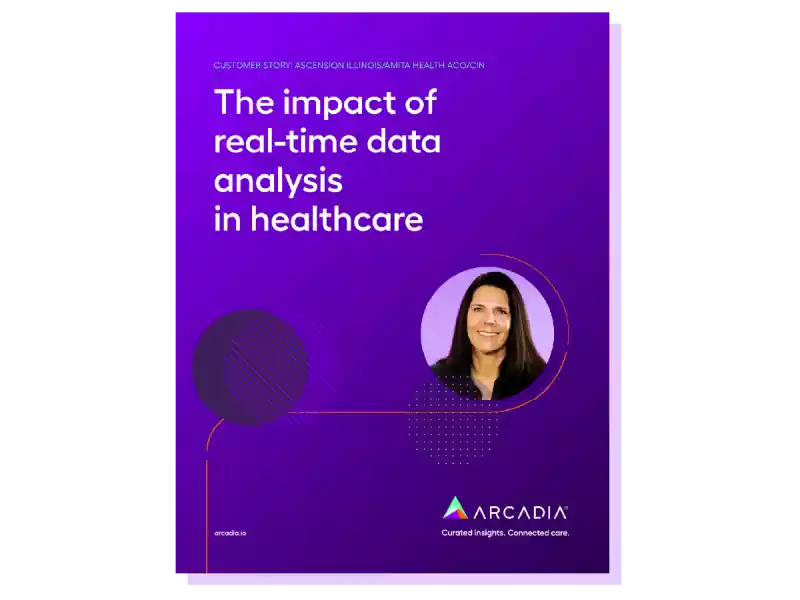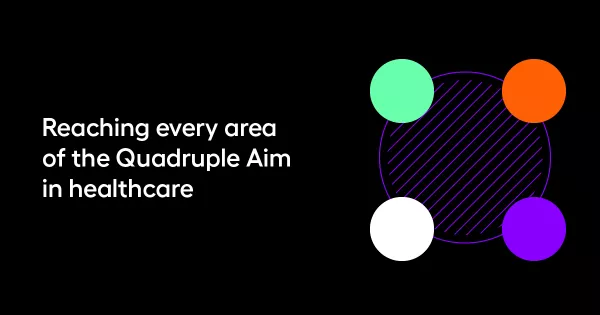The impact of real-time data analysis in healthcare
Michele Winiarz, System Director of Quality and Patient Safety at Ascension Illinois / AMITA Health ACO / CIN, drives performance through nimble analytics. Winiarz supports the AMITA Health Care Network, a clinically integrated network of physicians that are independent and employed by two major health systems, in understanding quality metrics, improving their results, and managing patient outreach.
“I just love the whole population health aspect of my job. It's always been a passion of mine ... it's always been something I prided myself on — giving the best quality care I could to a patient. To be able to do that in the community that I live in really makes me proud,” she said.

Download the Customer Story
Winiarz and her small but mighty team rely on data to achieve what’s called the Quadruple Aim, which includes sharing data with providers in real time, sending reminders to patients, identifying gaps in care quickly, and tracking metrics to improve costs.

Reaching every area of the Quadruple Aim in healthcare
Winiarz says clinical integration has allowed them to monitor every area of the Quadruple Aim for success. She believes the ability to bring data to providers in real-time and send messages to patients with the click of a button has been a gamechanger for the organization, allowing them to keep up with important goals.
They face acute challenges in this effort that include a vast network of providers with a range of knowledge about technology, multiple EHRs, and a large amount of data to organize and analyze.
“We're able to share data with providers in real-time, making them more efficient, more effective, and decreasing the administrative burden on their staff, which is definitely a provider satisfier. We're able to get data and reminders out to patients, helping to improve their care. We're identifying gaps in care more quickly so we can affect outcomes, and we’re definitely watching utilization metrics in real-time to improve our costs,” she said. “You pair that all together and you've got your Quadruple Aim.”

Innovative action to address barriers to quality care
While using the patient registry in Arcadia analytics, Ascension Illinois / AMITA Health ACO / CIN honed in on the zip codes where people experience the most challenges and discovered a big factor in missing appointments: transportation, a major SDoH concern.
“You would think in a metropolitan area like Chicago, it wouldn't be such an issue, but it really is, especially if there's a large distance between a specialist or the primary care provider (PCP), or to be able to get to the hospital for a test or a lab,” Winiarz explained. “The public transportation’s really good, but if you’re lower income, sometimes that's a challenge. On the weekends there aren’t as many buses and trains running. For our senior patients ... they're not driving or they’re relying on their children, so to be able to do things beyond the normal business hours, that really has been one of the main reasons why we do have gaps in care.”
Another area they focused on was readmission rates. Ascension Illinois / AMITA Health ACO / CIN worked with Arcadia to build a transitional care management dashboard, designed to put the patient first.
“Over the last three years patients that saw their primary care doctor in the 7 to 14 days after their discharge had lower readmission rates across the board. We were sharing this data, but we weren't seeing an increase in the number of transitional care management visits that our providers were performing,” Winiarz said of the problem.
With the dashboard, her team could show them data — the cost that's inferred from these readmissions and the difference in that readmission rate — which put a face to the problem.
“For the first time in three years, we started to see an improvement in that metric. That really was a system initiative, and we were doing it for our patients,” she said.

How technology helps Ascension Illinois / AMITA Health ACO / CIN thrive
The future of healthcare is more and more digital. Winiarz says to grow its primary care footprint, Ascension Illinois / AMITA Health ACO / CIN needs to connect providers clinically in other ways than forcing them to change their EHR. She thinks data and technology are the keys to providing evidence and pertinent data to providers and helping them reach goals.
“Working with Arcadia is really going to be the one caveat that keeps us successful in this market, because it will allow us to partner with more primary care providers who are on multiple EHRs, who don't have the resources or the willingness to change,” she said. “We can connect with them and get their data and share data back with them, and help improve their efficiencies and their patient care. That's going to speak volumes to our success in the future.”
They’re also the key to un-siloing departments and getting multiple teams on the same page. Arcadia’s analytic tools have played a big role in that effort, helping them streamline organization-wide initiatives.
“We were a population health department, but we tended to work in silos,” Winiarz explained. “Once we all started using Arcadia, we’re having more meetings, we're collaborating more internally, and it really has made us a stronger population health team. The quality team and the care management team are always doing things together. My team can see who's enrolled in care management, and the care management team can see what gaps in care patients have if they are enrolled in a care management program.”

Harness the power of data to deliver quality care
Real time data that supports providers and patients and meaningful metrics that track costs open doors to better patient outcomes. Watch more Customer Stories or request a demo to see how we can put your data to work, together.

